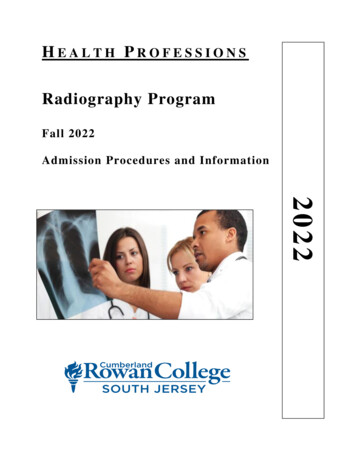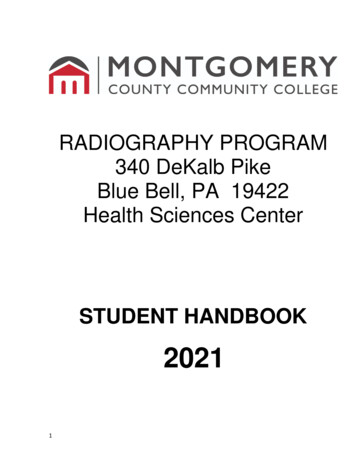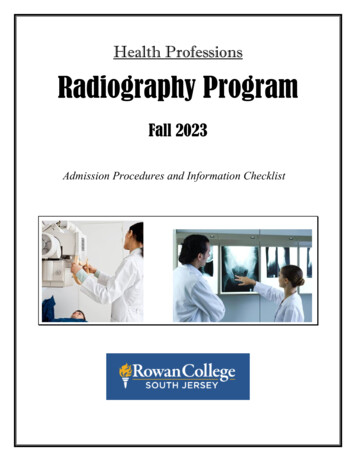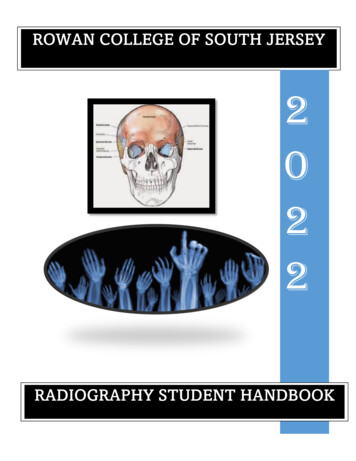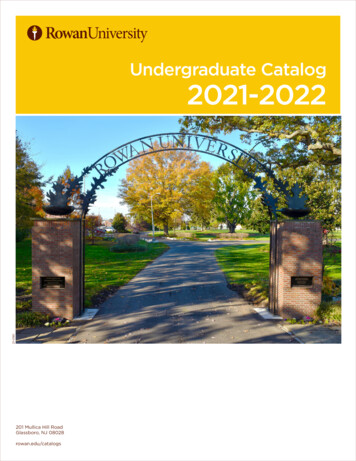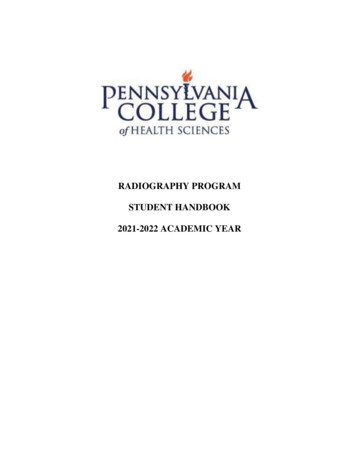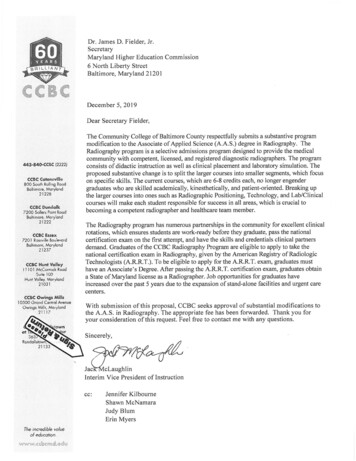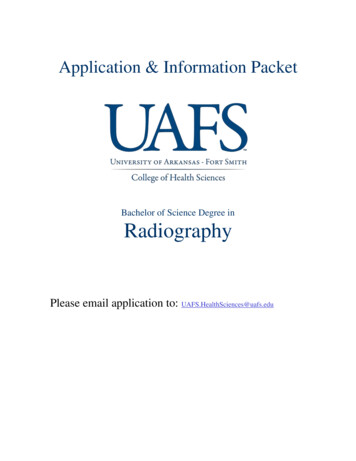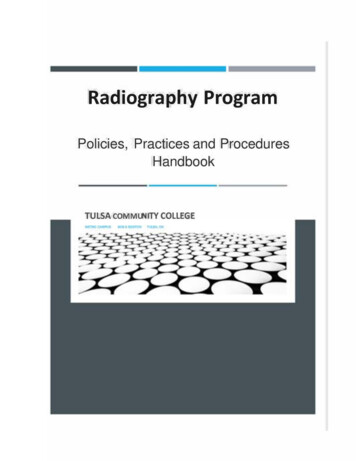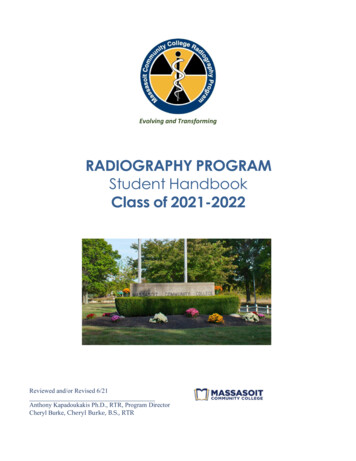
Transcription
Radiography ProgramStudent Handbook2021-2022Rowan College at Burlington County does not discriminate based on race, sex, sexual orientation, gender identity,religion, color, national or ethnic origin, age, disability, or veteran status. Visit rcbc.edu/hr for more details.*Information is current to the date of publication*1
WelcomeThe Radiography Program Faculty welcomes new and returning students. Our goal is to provide itsstudents with a high-quality radiography education that prepares them as caring, safe and competententry-level radiographers in today’s high-tech healthcare workplaces. We want to work cohesivelyto achieve this goal.We wish you success in your radiography education at Rowan College at Burlington County.The information in this handbook will help assist you through the program. Please become familiarwith each part and keep it as a reference.AccreditationJoint Review Committee on Education in Radiologic Technology20 N. Wacker Drive, Suite 2850Chicago, Illinois 60606-2901(312) 704-5300Radiologic Technology Board of ExaminersDepartment of Environmental ProtectionRadiation Protection ProgramsPO Box 415Trenton, NJ 08625(609) 984-5890Rev. 10/97, Rev. 4/98, Rev. 4/99, Rev. 4/00, Rev. 4/01, Rev. 12/01, Rev. 4/02, Rev. 4/03, Rev. 4/04, Rev. 4/05, Rev. 4/06, Rev. 4/07,Rev. 4/08, Rev.4/09, Rev.4/10, Rev. 4/11, Rev.2/12, Rev.3/13 & 10/13Rev. 4/14, Rev.7/14, Rev. 5/15, Rev. 4/16, Rev 8/192
Rowan College at Burlington CountyRadiography Program Staff1000 College CircleMt. Laurel, NJ 08054College Telephone Number: (856) 291-4283 extension 1410Facsimile: (609) 726-0628AdministrationKaren Montalto, PhD, RNDean of Health Scienceskmontalto@rcbc.eduPamela J. Evans MSRS R.T. (R) (M)Radiography Directorpjevans@rcbc.eduCoordinatorJeffrey S. Nelson BA., R.T. (R)Clinical Coordinatorjnelson@rcbc.eduAdjunct FacultyKarin Anderson AAS RT(R) (M)kanderson@rcbc.eduNancy Murray AAS RT(R)nmurray@rcbc.eduVirginia Guccini AAS RT(R)vguccini@rcbc.eduParul Soni AAS RT(R)psoni@rcbc.eduGenna Komala BS, RT(R)gkomala@rcbc.eduStaffDanielle GarciaDepartmental Secretarydgarcia@rcbc.eduTBAHealth Sciences Division CoordinatorRadiography Program Clinical SitesHackensack Meridian Health Southern Ocean Medical CenterVirtua Marlton HospitalVirtua Memorial HospitalVirtua Our Lady of Lourdes HospitalVirtua Voorhees HospitalVirtua Willingboro Hospital(609) 978-8932(856) 355-6125(609) 914-6000 ext. 43709(856) 668-8450(856) 247-3788(609) 835-2900 ext.42373
MissionIn support of Rowan College at Burlington County, a comprehensive community college, themission of the Radiography Program is to provide affordable educational experiences, so that thestudent may develop academically, clinically and professionally into a competent, entry-levelradiographer.Student Learning GoalsGoal 1: Students will have knowledge and skills required to be clinically competent inall radiographic tasks necessary for an entry level radiographer:Student Learning Outcomes:Students will apply positioning skills.Students will select technical factors.Students will utilize safe radiation protection practices.Students will pass the ARRT examination.Goal 2: Students will demonstrate communication skillsStudent Learning Outcomes:Students will demonstrate written communication skills.Students will demonstrate oral communication skills.Goal 3: Students will develop critical thinking skills.Student Learning Outcomes:Students will adapt standard procedures for non-routine patients.Students will critique images.Students will apply critical thinking skills to guide decisions regarding radiographypractice for patients and family members, the public and members of the health careteam.Goal 4: Students will model professionalism.Student Learning Outcomes:Students will demonstrate good work ethics.Students will summarize the value of life-long learning.Students will participate in personal and professional growth opportunities.Students will pursue additional education advancement.Program Effectiveness GoalsGoal 1: Five-year average credentialing examination pass rate of not less than 85% at firstattempt.Goal 2: Five-year average job placement rate of not less than 75% within six months ofgraduation.Goal 3: Annual program completion rates, 80% of the students will complete the programwithin 3 years of program start.Goal 4: Graduates will express satisfaction with the program, as assessed on the exitevaluation, 80 % of the graduates will be satisfied.Goal 5: Employer will express satisfaction with the graduates of the program as assessed onthe employer survey, 80% of respondents will be satisfied.4
Academic ProgressionThe Radiography Program requires 70 credits for graduation: 48 radiography credits and 22 credits in college general education courses. The graduate receives an Associate in Applied Science (AAS) degree for Radiographers.TranscriptsStudents taking supporting courses at other institutions must keep their records at RCBC current.Please arrange for transcripts to be sent to the Registrar so your records will include the correct preand co-requisites and graduation requirements. Transferred courses must have the same number ofcredits to be equivalent to RCBC’s courses.General education courses and support courses may be taken earlier than suggested and in anysequence. However, it is important to plan that all supporting courses indicated as pre- or corequisites to specific radiography courses are taken in the appropriate order.Example: RAD 150 is a co-requisite of RAD 107 so it must be taken no later than the samesemester as RAD 107 and prior to Radiography Clinical Procedures 3 (RAD 160).Co-requisite Courses: Semester 1o Introduction to Radiologic Scienceo Patient Care in Radiologic Scienceo Radiologic Image Production Characteristics, & Principleso Radiography Clinical Procedures 1o Clinical Practicum & Image Evaluation 1 Semester 2o Principles of Radiation Protection & Biologyo Digital Image Acquisition and Displayo Radiography Clinical Procedures 2o Clinical Practicum & Image Evaluation 2 Semester 3o Radiography Clinical Procedures 3o Clinical Practicum & Image Evaluation 3 Semester 4o Radiographic Imaging Equipmento Radiography Clinical Procedures 4o Clinical Practicum & Image Evaluation 4 Semester 5o Radiography Clinical Procedures 5o Clinical Practicum & Image Evaluation 5 Semester 6o Clinical Practicum & Image Evaluation 6Any student failing pre-or co-requisites or radiography courses (taken in sequence) must withdrawfrom the radiography program until these courses are successfully completed. Re-admission to theradiography program will be considered at that time on a space available basis only.5
Radiography CoursesRAD 107: Principles of Radiation Protection & BiologyRadiation effects on cells and living tissues are discussed. The principles and responsibilities ofradiation protection are presented. Federal and state regulations are identified. (2/0/0) Pre-requisites: RAD 113, RAD 117, RAD 127, RAD 140 and RAD 142 Co-requisite: RAD 129, RAD 150 and RAD 152RAD 113: Introduction to Radiologic ScienceThis course provides the student an overview of the foundations of radiography and thepractitioner’s role in health care delivery. Principles, practices and policies of health careorganizations are examined and discussed in addition to the professional responsibilities of theradiographer. The student is also introduced to the basic information concerning ethical and legalbehavior within a health care environment. (2/0/0) Pre-requisites: Fundamentals of Anatomy & Physiology 1, Fundamentals of Anatomy &Physiology 1 Lab, Medical Terminology, and College CompositionCo-requisite: Patient Care in Radiologic Science, Radiographic Image Production,Characteristics & Principles, Clinical Practicum & Image Evaluation 1, and RadiographyClinical Procedures 1RAD 117: Patient Care in Radiologic ScienceThe student is introduced to the methods of optimal patient care, including consideration for thephysical and psychological needs of the patient and family. Communication between thetechnologist and health care team is stressed. Routine and emergency patient care procedures aredescribed, to include infection control procedures using standard precautions. (2/0/0) Pre-requisites: Fundamentals of Anatomy & Physiology 1/including Lab, MedicalTerminology, and College CompositionCo-requisite: Intro to Radiologic Science, Radiographic Image Production, Characteristics &Principles, Radiographic Clinical Procedures 1, and Clinical Practicum & Image Evaluation1RAD 127: Radiographic Image Production, Characteristics & PrinciplesThe student establishes a knowledge base in the technical factors that govern the image productionprocess. This course focuses on the factors that influence the creation of the radiographic image.(2/0/0) Pre-requisite: Fundamentals of Anatomy & Physiology 1/including Lab, MedicalTerminology, and College Composition Co-requisite: Intro to Radiologic Science, Patient Care in Radiologic Science, RadiographyClinical Procedures 1, and Clinical Practicum & Image Evaluation 1RAD 129: Digital Image Acquisition & DisplayThe student will learn about the components, principles and operation of digital imaging systemsfound in diagnostic radiology. Factors that impact image acquisition, display, archiving andretrieval are discussed in detail. Principles of digital imaging quality assurance and maintenance arepresented as well. (2/0/0) Pre-requisite: Intro to Radiologic Science, Patient Care in Radiologic Science, RadiographicImage Production, Characteristics & Principles, Radiography Clinical Procedures 1 and6
Clinical Practicum & Image Evaluation 1Co-requisite: Principles of Radiation Protection & Biology, Radiography ClinicalProcedures 2, and Clinical Practicum & Image Evaluation 2RAD 140: Radiography Clinical Procedures 1The student is taught to perform radiographic procedures of the chest, upper extremity, shouldergirdle and abdomen. Anatomic structure and topographic landmarks are identified. Radiographicpositioning nomenclature, aids, accessory equipment, production of quality radiographic images andradiation protection procedures are studied. Laboratory materials are used to demonstrate clinicalapplications of theoretical principles and concepts. Achieved laboratory competency is measured.(2/2/0) Pre-requisite: Fundamentals of Anatomy & Physiology 1/including Lab, MedicalTerminology, and College Composition Co-requisite: Intro to Radiologic Science, Patient Care in Radiologic Science, RadiographicImage Production, Characteristics & Principles, and Clinical Practicum & Image Evaluation1RAD 142: Clinical Practicum & Image Evaluation 1The student is assigned to the radiology department in the first semester of a clinical educationcenter. The practical application of imaging of the following: chest, upper extremity, shoulder girdleand abdomen can be performed on actual patients through the competency process. Hands-onexperience is provided under the direct supervision of qualified radiographers.(0/0/16 Pre-requisite: Fundamentals of Anatomy & Physiology 1/including Lab, MedicalTerminology, and College Composition Co-requisite: Intro to Radiologic Science, Patient Care in Radiologic Science, RadiographicImage Production, Characteristics & Principles, and Radiography Clinical Procedures 1RAD 150: Radiography Clinical Procedures 2The student learns to perform radiographic procedures of the lower extremity, pelvic girdle andbony thorax. Anatomic structure and topographic landmarks are identified. Radiographicpositioning nomenclature, aids, accessory equipment, production of quality radiographic images andradiation protection procedures are studied. Laboratory materials are used to demonstrate clinicalapplications of theoretical principles and concepts. Achieved laboratory competency is measured.(2/2/0) Pre-requisite: Intro to Radiologic Science, Patient Care in Radiologic Science, RadiographicImage Production, Characteristics & Principles, Radiography Clinical Procedures 1 andClinical Practicum & Image Evaluation 1 Co-requisite: Principles of Radiation Protection & Biology, Digital Image Acquisition &Display, and Clinical Practicum & Image Evaluation 2 Principles of Radiation Protection &Biology, Digital Image Acquisition & DisplayRAD 152: Clinical Practicum & Image Evaluation 2The student is assigned to the radiology department in the second semester of a clinical educationcenter. The practical application of imaging of the following: bony thorax, lower extremity, andpelvic girdle can be performed on actual patients through the competency process. Hands-onexperience is provided under the direct supervision of qualified radiographers. (0/0/16) Pre-requisite: Intro to Radiologic Science, Patient Care in Radiologic Science, RadiographicImage Production, Characteristics & Principles, Radiography Clinical Procedures 1 andClinical Practicum & Image Evaluation 17
Co-requisite: Principles of Radiation Protection & Biology, Digital Image Acquisition &Display, and Radiography Clinical Procedures 2RAD 160: Radiography Clinical Procedures 3The student learns to perform radiographic procedures of the cervical, thoracic, lumbar, sacrum,coccyx, and cranium. Anatomic structure and topographic landmarks are identified. Radiographicpositioning nomenclature, aids, accessory equipment, production of quality radiographic images andradiation protection procedures are studied. Laboratory materials are used to demonstrate clinicalapplications of theoretical principles and concepts. Achieved laboratory competency is measured.(2/2/0) Pre-requisite: Principles of Radiation Protection & Biology, Digital Image Acquisition &Display, Radiography Clinical Procedures 2, and Clinical Practicum & Image Evaluation 2 Co-requisite: Clinical Practicum & Image Evaluation 3RAD 162: Clinical Practicum & Image Evaluation 3The student is assigned to the radiology department in the third semester of a clinical educationcenter. The practical application of imaging of the following: skull, spine, and mobile can beperformed on actual patients through the competency process. Hands-on experience is providedunder the direct supervision of qualified radiographers. (0/0/16) Pre-requisite: Principles of Radiation Protection & Biology, Digital Image Acquisition &Display, Radiography Clinical Procedures 2, and Clinical Practicum & Image Evaluation 2 Co-requisite: Radiography Clinical Procedures 3RAD 235: Radiographic Imaging EquipmentThe content of this course is designed to establish a knowledge base in radiographic, fluoroscopic,and mobile equipment requirements and design. The content also provides a basic knowledge ofquality control. Upon completion, the student will be able to understand the difference inperformance and testing of imaging equipment. (2/0/0) Pre-requisite: Clinical Procedures 3 and Clinical Practicum & Image Evaluation 3 Co-requisite: Radiography Clinical Procedures 4 and Clinical Practicum & ImageEvaluation 4RAD 240: Radiography Clinical Procedures 4The student is taught to perform radiographic procedures of the mobile radiography, pediatric,digestive, biliary, reproductive and urinary systems. Radiographic positioning aids, accessoryequipment, use of contrast media, production of quality radiographs and radiation protection arepresented. Laboratory materials are used to demonstrate clinical applications of theoreticalprinciples and concepts. Achieved laboratory competency is measured. (2/2/0) Pre-requisite: Clinical Practicum & Image Evaluation 3 and Radiography ClinicalProcedures 3 Co-requisite: Radiographic Imaging Equipment and Clinical Practicum & Image Evaluation4RAD 242: Clinical Practicum & Image Evaluation 4The student is assigned to the radiology department in the fourth semester of a clinical educationcenter. The practical application of imaging of the following: biliary, digestive, urinary, andreproductive systems can be performed on actual patients through the competency process. Hands8
on experience is provided under the direct supervision of qualified radiographers. (0/0/24) Pre-requisite: Clinical Practicum & Image Evaluation 3 and Radiography ClinicalProcedures 3 Co-requisite: Radiographic Imaging Equipment and Radiography Clinical Procedures 4RAD 250: Radiography Clinical Procedures 5The student is taught radiographic advanced imaging procedures including mammograms,arthrograms, myelograms, venograms, and arteriograms. Radiographic positioning aids, accessoryequipment, production of quality radiographs and radiation protection are presented. The studentwill also evaluate radiographic images of all required program competencies. Finally, the student isintroduced to the basic concepts of pharmacology, venipuncture and administration of diagnosticcontrast agents and intravenous medications. The appropriate delivery of patient care duringvenipuncture is emphasized. (2/0/0) Pre-requisite: Radiographic Imaging Equipment, Clinical Practicum & Image Evaluation 4and Radiography Clinical Procedures 4 Co-requisite: Clinical Practicum & Image Evaluation 5RAD 252: Clinical Practicum & Image Evaluation 5The student is assigned to the radiology department in the fifth semester of a clinical educationcenter. The practical application of imaging of the following: bone survey, long bone measurement,bone age, foreign body, scoliosis survey, hysterosalpinography, myelography, and arthrography canbe performed on actual patients through the competency process. Hands-on experience is providedunder the direct supervision of qualified radiographers. (0/0/24)\ Pre-requisite: Radiographic Imaging Equipment, Clinical Practicum & Image Evaluation 4and Radiography Clinical Procedures 4 Co-requisite: Radiography Clinical Procedures 5RAD 262: Clinical Practicum & Image Evaluation 6Students are assigned to the radiology department in the sixth semester of a clinical education centerfor practical application of the information presented in the prerequisite and co-requisite courses.This course allows the student sufficient clinical practicum to achieve entry level clinicalcompetency. Hands-on experience is provided under the supervision of qualified radiographers.Clinical rotations in advanced modalities may be made available during this semester with thepermission of the clinical coordinator. Achieved competency and pertinent initial and final clinicalcompetency testing is performed. (0/0/24) Pre-requisite: Clinical Practicum & Image Evaluation 5 and Radiography ClinicalProcedures 5 Co-requisite: NoneRadiography Support CoursesFundamentals of Anatomy and Physiology I (BIO 110/111)Fundamentals of Anatomy and Physiology II (BIO 114/115)Medical Terminology (HIT 106)General Psychology (PSY 101)Principles of Sociology (SOC 101)English Composition I (ENG 101)Public Speaking (SPE 102)Fundamentals of Computer Science (CIS 101)9
Introduction to Statistics (MTH 107)All general education credits in the A.A.S. degree for radiography students at Rowan College atBurlington County afford the graduate the foundation to easily pursue additional higher educationalprograms.Please Note: There are no substitutes for radiography support/general education courses.Non-Radiography courses taken earlier than required may be retaken (twice) to improve the grade.The student’s progress in the radiography program will not be affected until the co-requisite courseis reached.For students to enter or remain in the radiography program, they must have obtained a grade of “C”or higher in all the radiography support courses, ENG 101, BIO 110, BIO 111, BIO 114, BIO 115,HIT 106, SOC 101, PSY 101, MTH 107, CIS 101 and SPE 102.A student in the radiography program receiving less than a “C” grade in any of the above courseswill not be given credit toward meeting radiography requirements. If a student receives less than“C” in a co-requisite course, the student will be required to drop out of the radiography programuntil a “C” grade or better has been attained. At the next application cycle, the student may applyfor readmission.Revised: 5/02, 5/09, 2/17, 8/19Reviewed: 5/09, 4/10, 4/11, 4/12, 3/13, 4/14, 4/15, 4/16, 6/1810
Academic InformationGrading Standard PracticeMaintaining GPAStudents must maintain a GPA of 2.80 or better to remain in the program. If the GPA falls below a2.80 GPA, the student must withdraw from the program and apply to reenter on a space-availablebasis when the GPA is above 2.80. Students should monitor their GPA at the end of each semester.Radiography Course Grading ScaleA95-100A90-94B 85-89B80- 84C 79C70-78DFSU60-69less than 60%SatisfactoryUnsatisfactoryA student must achieve a grade of 79% or higher in every RAD theory course and 85% or higher inthe RAD clinical /laboratory course to advance. A grade below a 79% in a RAD theory course or below an 85% in a RAD clinical/laboratory course requires the student to repeat that course before advancing to the nextsemester or graduating. If a student fails one or more first semester radiography course(s) he/she will be dismissedand there is no consideration for readmission into the program. A student who fails one Radiography course must take a Leave of Absence and retake thatcourse the following year (depending on availability). If a student fails more than oneRadiography course (over the life of the program) he/she will be dismissed and there is noconsideration for readmission into the program. If the student is readmitted to the Radiography Program, he/she must repeat the entire course(theory, clinical and lab components).Grade AppealStudent Grade Appeals NUMBER 217The purpose of this policy amendment is to reaffirm and provide technical revision and clarificationto Board Policy 217 by explicating the applicable time frame and associated deadline for studentgrade appeals that are governed by this Policy, and companion Procedure.The policy applies to all students enrolled in credit bearing courses, offered under any mode ofdelivery.The purpose of this policy is to offer students an avenue to discuss and resolve problems, in a timelymanner that may arise with his/her educational progress. This document establishes a policy thatdefines a grade appeal process that provides due process as articulated in Procedure 217, forstudents in the event of a final grade dispute with a course professor.Grade appeals governed under this policy must be formally initiated by a student in a timely manner11
that shall not exceed the conclusion of the next successive semester of the regular academic year or,in the case of a summer term appeal, the next successive Fall semester.Student grade appeals that do not conform to this deadline for appeal shall be considered untimelyand without merit.This policy requires:(Step 1), a written request for a formal meeting with the course professor related to the gradedispute,(Step 2), a review and recommendation by the division Dean, and(Step 3) an appeal to the Provost of Academic Programs who will convene the Grade.Appeal Committee to review the records relevant to any dispute and make a recommendation to thePresident or designee, whose decision will be final.SUPERSEDES: July 1, 2007EFFECTIVE: March 19, 2013Reviewed: 4/14, 4/15, 4/16, 7/17, 8/19LAMBDA NULambda Nu is a national honor society for the radiologic and imaging sciences. Its objectives areto: Foster academic scholarship at the highest academic levels Promote research and investigation in the radiologic and imaging sciences Recognize exemplary scholarshipCriteriaIndividuals who have achieved academic honors are welcome to apply for acceptance into LambdaNu. The criteria are: Possess a GPA of 3.7 or higher on a 4.0 scale after three semesters of the radiographyprogram. Enrollment in a radiologic or imaging sciences program as a full-time Radiography studentfor at least three terms. Evidence of professional commitment beyond minimal requirements of the programincluding, but not limited to:o Actively pursuing an independent research papero Active membership in a professional organization, as evidenced by: Holding office or committee appointments Preparing for presentation of a professional paper or poster Preparing for competition in a Quiz-Bowl No academic or clinical disciplinary actions on file during the duration of the program.InvitationIndividuals meeting the criteria will be sent an invitation to become a member of Lambda Nu. Oncethe student accepts the invitation, an application for membership and a copy of the bylaws areemailed approximately in May.12
ApplicationThe application must be completed by the student and signed by the program director. Theapplication is accompanied with a personal check sent to the National Lambda Nu organization.InductionInduction into the Lambda Nu Honor Society will occur in conjunction with the Diagnostic MedicalSonography program.Established: 4/13Reviewed: 4/14, 4/15, 4/16, 7/17, 6/18, 8/19Graduation - Standard PracticeThe graduate of the radiography program is educated to function as an entry-level diagnosticradiographer in various settings, such as hospitals, imaging centers and private offices. Thegraduate integrates the component of Radiologic science to function as a member of the health caredelivery team. Ongoing professional development as a member of the discipline is an expectedbehavior of all graduates. Participation in continuing radiography education is required of allregistered technologists. Demonstration of accountability to peers and consumers of radiologicservices and contributions to improving the delivery of health care are also expected.Graduation RequirementsTo be eligible for graduation, the student must: meet all didactic education requirements meet all clinical education requirementsAchieve minimal terminal competencies by being able to: provide basic patient care and comfort apply principles of body mechanics recognize emergency patient conditions initiate first aid and basic life support practice radiation protection for the patient, self and others position the patient and imaging system to perform radiographic procedures modify standard procedures to accommodate for patient condition determine proper exposure factors to obtain the following in accordance with the ALARAconcept:o diagnostic quality radiographic imageso adapt exposure factors based upon various conditions/situations perform basic mathematical functions apply knowledge of quality assurance objectively critique recorded images for various factors operate radiographic imaging equipment and accessory devices evaluate radiographic system performance within safe limits and communicate results exercise independent judgment and discretion in the technical performance of medicalimaging procedures demonstrate an acceptable standard of medical ethics in the performance of all duties recognize the need to keep skills and knowledge through continuing education achieve program goals and educational objectives13
fulfill all financial obligations to the college earn a minimum of 70 credit hours with a minimum cumulative grade point average of 2.80.The 70 credit hours must satisfy the curriculum specified by the program.NJ State LicensureUpon successful completion of the ARRT exam, the student may apply for a license in radiography.This application is through the State of New Jersey, Department of Environmental Protection andEnergy, Radiologic Technology Board of Examiners. The program is responsible for the provisionof all necessary applications and the information required.Submission of the appropriate application and fee is the responsibility of the student. Theapplication cannot be sent until the results from the ARRT are received. The application must beaccompanied by the fee, a copy of the ARRT Results, and a letter from the Program Director statingcompletion of the accredited program (a copy of the degree may not be available at the time ofprogram completion).National RegistryThe program director (or designated program official) will direct expected graduates in applying forthe American Registry of Radiologic Technologists national certification examination. The programis responsible for the provision of all necessary information required. The program is notresponsible for submitting or paying application fees.RCBC graduationIt is the responsibility of the graduate to submit the appropriate application to RCBC for theobtainment of the AAS degree in radiography within the time frames published. Students may go tohttp://www.rcbc.edu/graduation for specific information.Revised: 2/06, 5/05, 5/09, 5/11Reviewed: 5/09, 4/10, 4/12, 3/13, 4/14, 5/15, 4/16, 6/17, 8/19Graduation AwardsThere are several awards that are given upon the completion of the program.Academic AwardThe Academic Award is presented to the student that has the highest RCBC cumulative GPA.Should two students have the same outstanding GPA, the award will be given to the student whohas acquired the greatest number of credits at RCBC. The names of the students eligible will besent to the Program Director at the announcement of the award ceremony date. This award is givenout at the ceremony.Kenneth L. Queener, R.T. Award of Technical ExcellenceKenneth Queener was retired military and worked as a technologist at Memorial Hospital ofBurlington County. He had outstanding clinical skills and deeply cared for the students. Radiologypersonnel at all the clinical affiliates are asked to select one student, who has produced the highestquality radiographs with the lowest radiation exposure (repeats) to the patient.14
Patricia Ann Taylor, R.T. Humanitarian AwardPatricia Ann Taylor was a technologist that is honored through the Humanitarian Award. She hadgraduated from the Memorial Hospital of Burlington County’s program and was employed as atechnologist when she lost her battle with cancer.Radiology personnel are asked to select the student who best meets the follow
The Radiography Program Faculty welcomes new and returning students. Our goal is to provide its students with a high-quality radiography education that prepares them as caring, safe and competent entry-level radiographers in today's high-tech healthcare workplaces. We want to work cohesively to achieve this goal.
